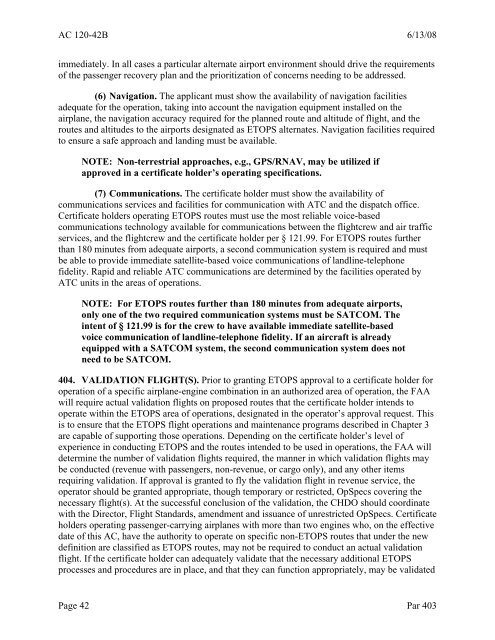AC 120-42B ETOPS and Polar Ops - Code7700
AC 120-42B ETOPS and Polar Ops - Code7700
AC 120-42B ETOPS and Polar Ops - Code7700
Create successful ePaper yourself
Turn your PDF publications into a flip-book with our unique Google optimized e-Paper software.
<strong>AC</strong> <strong>120</strong>-<strong>42B</strong> 6/13/08immediately. In all cases a particular alternate airport environment should drive the requirementsof the passenger recovery plan <strong>and</strong> the prioritization of concerns needing to be addressed.(6) Navigation. The applicant must show the availability of navigation facilitiesadequate for the operation, taking into account the navigation equipment installed on theairplane, the navigation accuracy required for the planned route <strong>and</strong> altitude of flight, <strong>and</strong> theroutes <strong>and</strong> altitudes to the airports designated as <strong>ETOPS</strong> alternates. Navigation facilities requiredto ensure a safe approach <strong>and</strong> l<strong>and</strong>ing must be available.NOTE: Non-terrestrial approaches, e.g., GPS/RNAV, may be utilized ifapproved in a certificate holder’s operating specifications.(7) Communications. The certificate holder must show the availability ofcommunications services <strong>and</strong> facilities for communication with ATC <strong>and</strong> the dispatch office.Certificate holders operating <strong>ETOPS</strong> routes must use the most reliable voice-basedcommunications technology available for communications between the flightcrew <strong>and</strong> air trafficservices, <strong>and</strong> the flightcrew <strong>and</strong> the certificate holder per § 121.99. For <strong>ETOPS</strong> routes furtherthan 180 minutes from adequate airports, a second communication system is required <strong>and</strong> mustbe able to provide immediate satellite-based voice communications of l<strong>and</strong>line-telephonefideli ty. Rapid <strong>and</strong> reliable ATC communications are determined by the facilities operated byATC units in the areas of operations.NOTE: For <strong>ETOPS</strong> routes further than 180 minutes from adequate airports,only one of the two required communication systems must be SATCOM. Theintent of § 121.99 is for the crew to have available immediate satellite-basedvoice communication of l<strong>and</strong>line-telephone fidelity. If an aircraft is alreadyequipped with a SATCOM system, the second communication system does notneed to be SATCOM.404. VALIDATION FLIGHT(S). Prior to granting <strong>ETOPS</strong> approval to a certificate holder foroperation of a specific airplane-engine combination in an authorized area of operation, the FAAwill require actual validation flights on proposed routes that the certificate holder intends tooperate within the <strong>ETOPS</strong> area of operations, designated in the operator’s approval request. Thisis to ensure that the <strong>ETOPS</strong> flight operations <strong>and</strong> maintenance programs described in Chapter 3are capable of supporting those operations. Depending on the certificate holder’s level ofexperience in conducting <strong>ETOPS</strong> <strong>and</strong> the routes intended to be used in operations, the FAA willdetermine the number of validation flights required, the manner in which validation flights maybe conducted (revenue with passengers, non-revenue, or cargo only), <strong>and</strong> any other itemsrequiring validation. If approval is granted to fly the validation flight in revenue service, theoperator should be granted appropriate, though temporary or restricted, OpSpecs covering thenecessary flight(s). At the successful conclusion of the validation, the CHDO should coordinatewith the Director, Flight St<strong>and</strong>ards, amendment <strong>and</strong> issuance of unrestricted OpSpecs. Certificateholders operating passenger-carrying airplanes with more than two engines who, on the effectivedate of this <strong>AC</strong>, have the authority to operate on specific non-<strong>ETOPS</strong> routes that under the newdefinition are classified as <strong>ETOPS</strong> routes, may not be required to conduct an actual validationflight. If the certificate holder can adequately validate that the necessary additional <strong>ETOPS</strong>processes <strong>and</strong> procedures are in place, <strong>and</strong> that they can function appropriately, may be validatedPage 42 Par 403
















